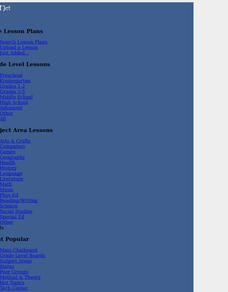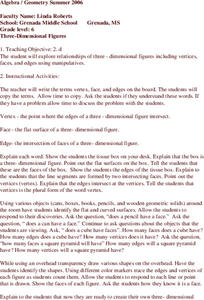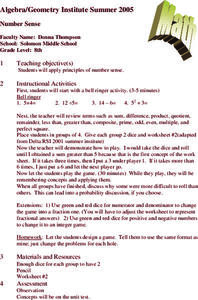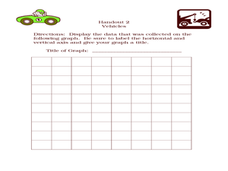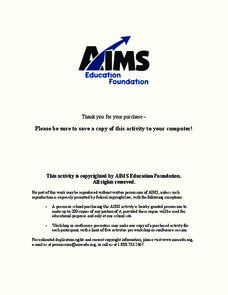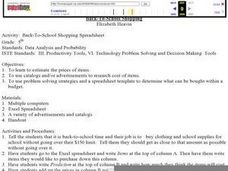Curated OER
Subtracting Integers: Math, Physical Education, Dancing, Negative Numbers
Students demonstrate their understanding of positive and negative integers by adding and subtracting. More importantly, students explain why a negative number, subtracted from a negative number, changes the operation.
Curated OER
Addition and Subtraction in Center Time
First graders use bean bags, dominos, number trains, counters, paper clips, flashcards, beads and more in a variety of centers to practice basic addition and subtraction facts.
Curated OER
Race Track (Culminating Activity)
Students graph and solve linear equations. In this algebra lesson, students use the slope and y-intercept to graph lines. They relate lines to the real world using different applications.
Curated OER
Numbers Activity
Students practice identifying quantities of items and materials using numbers. In this counting lesson, students read The Gummi Bear Counting Book by Lindley Boegehold, and utilize a bag of gummy bears as a counting tool....
Curated OER
Prime Time
Seventh graders practice determining the prime factorization of composite numbers. They create Christmas factor trees for prime numbers greater than 100. They decorate their final products with markers, crayons, colored pencils, glitter...
Curated OER
FOOTSTEPS IN TIME
Students measure and correlate their foot lengths and body heights, then use this data to estimate height of Laetoli hominids. They use metric measurement and graphing to determine these heights.
Environmental Protection Agency (EPA)
How Much Water Do You Use?
Incorporate reading strategies, math, research, and the scientific method into one lesson plan about water conservation. After reading a story about a landlady trying to determine how many people are living in an apartment, learners...
Curated OER
Around the Town
Students explore reading maps. In this map reading lesson, students compare distances fom place to place. Students work in groups and predict the distance then find the actual distance using string or rulers.
Curated OER
Identifying Faces, Edges, and Vertices
Fourth graders examine faces, edges, and vertices. In this geometry lesson, 4th graders participate in classroom activities that require them to compare geometric shapes, figures, and models.
Curated OER
Ratios
Sixth graders use ratios to solve unit problems. Pupils write ratios in three different ways. In groups, they perform a bean activity, find ratios, and write them in simplest form.
Curated OER
How Small is It?
Pupils better understand what a concentration of one part per million means through activities. Students discuss "Maximum Contaminant Level" of a toxic in the water. They measure the classroom to find out how many cubic centimeter blocks...
Curated OER
Three-Dimensional Figures
Sixth graders explore three-dimensional objects. Using various objects found in the classroom, they identify faces, edges, and vertices of objects. Students create their own objects. They describe the polydron, telling the faces,...
Curated OER
Number Sense
Eighth graders participate in a lesson that is concerned with reviewing basic math concepts using the four operations. The activity is composed of a math game that is played by them.
Curated OER
Cubic Unit Models
Fourth graders find the volume of solids. In groups, 4th graders use spinners to determine the dimensions of solids. They construct the shapes, creating a model of the figure Students count the cubes in the model to determine the...
Curated OER
Show Me The Data!
Pupils create a bar graph. They will collect and organize data to turn into bar graphs. They create graphs for the favorite sports of the class, color of M&M's, and types of cars passing by.
Curated OER
Blow and Go
Students discover how air can move things by using their breath. In this physics lesson, students hypothesize then attempt to move a pencil 1 meter using nothing but their breath. Students record data from their experiment including...
Curated OER
Probability
Fifth graders participate in a instructional activity that is concerned with the mastery of math concepts related to probability. They play a math game that is an adaptation from Rock, Paper, and Scissors.
Curated OER
Introduction to Measuring Length in Customary Units
Students explore customary units of measurement. Students use yardsticks, rulers, and adding machine paper to measure specific units as directed by the teacher. Through completing this hands-on activity, they actively investigate units...
Curated OER
Treats in a Basket
Young scholars explore probability by participating in an experimental activity. In this number statistics lesson, students collaborate in groups in which they move a game piece around a board. Young scholars calculate their probability...
EngageNY
Comparison Shopping—Unit Price and Related Measurement Conversions II
Which rate is greater and by how much? Pupils continue to compare rates to solve problems in the 20th portion of a 29-part series. Rates are presented in a variety of representations either using the same representation or different...
Virginia Department of Education
Functions 2
Demonstrate linear and quadratic functions through contextual modeling. Young mathematicians explore both types of functions by analyzing their key features. They then relate these key features to the contextual relationship the function...
Curated OER
Calendars
Second graders read books and discuss the names of the days of the week, months, and their holidays and seasons. They discover the concept of the days in order, practicing sequencing using a pocket chart and perform a matching activity...
Curated OER
Back-To-School Shopping
Fifth graders estimate the prices of items to be bought for back to school. They use catalogs and/or advertisements to research the cost of each of the items. They use problem solving strategies and a spreadsheet template to determine...
Curated OER
Mystery Jars
Youngsters discover ways to estimate. They will use two jars with large and small items and estimate the number of items. Then record their estimate and explain why they answered the way they did. They try this experiment with different...


